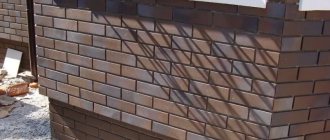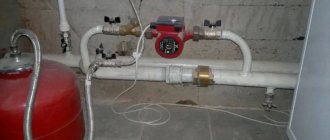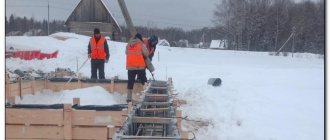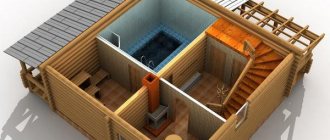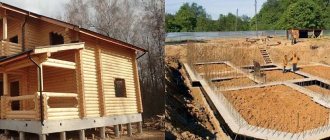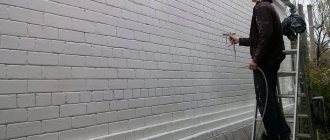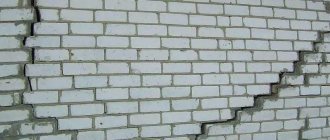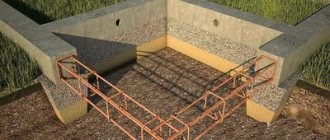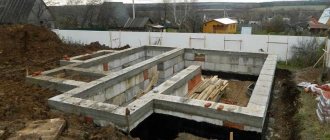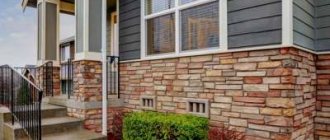Among shallow foundations, the slab foundation is considered the most durable and reliable. Another advantage is the relatively small volume of excavation work, but this is a common feature of all foundations with shallow burial in the ground. The only drawback is the high cost of materials and work, which is due to the large volume of concreting and the need to create a reinforcement frame over the entire base area. But in principle, it is no more expensive than a buried strip foundation, especially if you also take into account concrete floors on the ground of the basement.
A slab foundation allows you to build a house on sand Source kamtehnopark.ru
Scope and calculation features
The main purpose is to use it as a foundation on soft soils with a maximum load-bearing capacity of up to 2.5 kg/cm2. This includes sands - silty and medium density, clays and plastic loams, peat and moist soils. Moreover, it is the level of soil moisture that largely determines its load-bearing capacity - when wet, it literally “floats”, losing its strength properties. Therefore, drainage, waterproofing and blind areas play an important role in the arrangement of this type of foundation.
Reliable waterproofing is an important component of any foundation Source olestnicah.ru
One of the advantages is often given the argument that you can make a monolithic slab with your own hands. But even if we do not consider the issues of choosing the type of concrete and the parameters of the reinforcement frame, such an important stage remains as calculating the dimensions of the slab. And if there is a certain clarity with the area (the size of the house plus a small margin on each side), then the thickness of the slab is not easy to calculate.
The recommended range of foundation slab thickness for low-rise construction is 10-40 cm.
But this range also includes “light construction” in the form of a garage or summer kitchen, and a two-story house with an attic. If you make the slab not “thick” enough or choose the wrong thickness of the reinforcing rod (or cell size), then it will not be able to withstand the total load. An excessive margin of safety leads to an increase in the cost of an already expensive foundation, and an excessive amount of concreting will make the entire structure heavier, and the soil may not be able to withstand the total load.
There is another option with a diametrically opposite scope of application - the slab is installed on rocky and coarse soils with very high load-bearing properties. In this case, it rather levels the construction site rather than redistributing the load from the structure.
Another feature of this foundation is that the laying of pipelines must be done at the stage of the zero cycle Source xpcenter.ru
How to pour a monolithic foundation slab - technology for pouring a concrete base
Pouring a foundation slab is a responsible process that is carried out in accordance with technology requirements.
Technology for pouring concrete base
The algorithm for constructing a slab-type reinforced concrete foundation involves the following stages:
- Preparatory activities. They are carried out before the start of construction work and include geodetic surveys, calculations, project development, and determination of the need for building materials.
- Excavation. They are carried out using special equipment after clearing the construction site of debris, roots and vegetation. The technology involves leveling the surface and marking.
- Construction of a damping cushion. The backfill is made using a mixture of sand and gravel. The materials are evenly distributed over the surface of the future foundation and thoroughly compacted.
- Installation of formwork elements. To make the formwork structure, moisture-resistant plywood, metal sheets or planed boards are used, which are installed along the contour of the foundation.
- Assembly and installation of reinforcement cage. Pre-cut reinforcing bars are connected with tying wire into a strength lattice and installed inside the formwork.
- Preparation of concrete solution and pouring the working mixture into the formwork. It is important to correctly calculate the volume of concrete mixture to perform concreting in one step.
Let us dwell on the features of performing the main stages.
Construction of a slab foundation - calculation of materials and design
The pouring of the monolithic slab is carried out after completion of the preparatory work, which includes the following operations:
- Study of the nature of the soil.
- Determination of groundwater depth.
- Calculation of the load characteristics of the base.
- Development of project documentation.
- Determining the required amount of materials.
After completing the preparatory work, the monolithic slab is poured.
Knowing the overall dimensions of the foundation slab, it is easy to determine its volume and calculate the need for materials. To calculate the amount of reinforcement, you should be guided by the design documentation.
Preparing the site for a reinforced concrete foundation
When performing excavation work, follow the following procedure:
- Remove debris from the site.
- Remove the vegetation along with the root system.
- Level the surface of the site.
- Mark the outline of the future foundation.
- Excavate soil for a shallow foundation.
- Plan the surface of the bottom of the pit.
All that remains is to lay geotextiles and install drainage lines.
How to form a cushion for a monolithic foundation
The foundation slab is poured onto a previously prepared surface. To arrange the pillow, do the following:
- Mix the gravel and sand thoroughly.
- Distribute the mixture evenly over the foundation area.
- Compact the bedding, adding water as you compact.
To get a solid foundation for a future building, figure out how to pour a slab under the foundation.
Constructing formwork for a slab foundation on your own
Carrying out the formwork installation work yourself does not cause any difficulties. Procedure:
A foundation slab is poured onto a previously prepared surface.
- Prepare materials, cut blanks for formwork.
- Assemble panel elements with a height corresponding to the thickness of the slab.
- Install formwork panels around the perimeter of the slab foundation.
It is important to ensure the immobility of the formwork structure by installing supports on the outside. When performing work, pay attention to the tightness of the formwork contour.
How to assemble a load-bearing frame and lay reinforcement
Carry out the activities for assembling the power grid according to the following algorithm:
- Cut blanks of the required sizes from reinforcing steel.
- Lay the longitudinal rods of the lower tier in increments of 20-25 cm.
- Connect them with tying wire with cross members.
- Secure the vertical bars of the corrugated reinforcement.
- Assemble the reinforcement mesh of the upper tier.
- Secure the assembled grid with annealed wire.
- Place the reinforcement cage on special supports.
Place the reinforcement grid in the formwork after laying the waterproofing material.
How to pour a slab under a monolithic foundation
When constructing a slab foundation, you should figure out how to fill it in compliance with the technology. It is important to first determine the required volume of concrete mixture and choose a method for making the solution.
Possible options:
- the use of ready-made mixtures delivered to the work site in mixers. Concrete is transported along a chute and distributed inside the formwork by auxiliary workers;
- independent preparation of the solution using an electric concrete mixer. The limited capacity of the container significantly increases the cycle time;
- using a powerful concrete pump. Special equipment with a sliding rod allows the solution to be supplied through a concrete pipeline, which speeds up the concreting process.
Pouring a slab under a monolithic foundation.
Procedure for concreting:
- Fill the formwork with the prepared solution.
- Spread the concrete evenly.
- Level the surface.
- Compact the concrete mass thoroughly.
Professional builders will always tell you how to pour a monolithic foundation slab.
How to make your own concrete mix
Self-pouring a concrete slab requires the mandatory use of the following components:
- cement, which acts as a binder;
- sand and gravel used as filler;
- water added to the desired plasticity of the solution.
The optimal ratio of these bulk components is 1:3:5. To prepare concrete, mix the ingredients evenly, gradually adding water until the mixture becomes creamy.
How to properly pour a slab foundation under a house
It is not enough to simply prepare concrete and fill the formwork with it. It is important to understand how to properly pour a slab under a house.
Follow these guidelines for pouring concrete:
- do not allow interruptions in the supply of solution;
- compact the concrete with a deep or surface vibrator;
- maintain constant humidity of the array by periodically moistening;
- Lay polyethylene on the poured foundation to retain moisture.
Remember that the process of concrete hardening until it reaches working strength lasts 28 days.
What is taken into account when calculating the foundation
When calculating a monolithic slab foundation, the total load is taken into account, which includes:
- weight of the building, including finishing materials;
- the weight of the plate itself;
- engineering systems equipment;
- communications;
- furniture and household appliances;
- wind and snow pressure.
Atmospheric loads are temporary, but they are taken into account as permanent. They are defined as statistical characteristics given for each region in the tables of regulatory documents. They cannot be neglected - in some areas, wind loads and snow pressure are large, and in terms of per square meter of the foundation they are comparable to the specific gravity of equipment, household appliances and furniture.
Such a layer of snow is a serious test for any home Source bgderab.ru
“Amateur” developers use a simpler method of calculating slab thickness. He proceeds from the position that a low-rise building requires a reinforcing frame made of double mesh. The distances from the bottom and top surfaces of the slab to the reinforcement are taken to be 50 mm, the distance between the chords is more than 70 mm, the rod diameter is in the range of 12-16 mm. And the calculation formula comes down to the following amount: 2x50+70+4x(12-16)=218-234 mm. And since the thickness is rounded up in multiples of 50 mm, it turns out that it is equal to 250 mm. The bearing capacity of the foundation is finally “regulated” by choosing the diameter of the reinforcement and the grade of concrete.
But it must be emphasized once again that this is a very approximate method, and in some cases it may not “work”, so all calculations must be carried out by specialists.
Dependence on different types of structures
The design of the foundation of a future building is carried out not only taking into account the type of soil and the location of the land plot, but is also based on the area of the building and the building material from which it will be built. The size of the future house and its walls affect the loads, which should also be reflected in the capital of the structure. For example, for a frame-panel one-story house made of SIP panels, it will be sufficient to arrange a pile-strip shallow foundation type.
A structure made of fragile aerated concrete blocks requires a different type of foundation. The slightest shift of the foundation will lead to cracking of the walls, so a monolithic recessed strip foundation made of reinforced concrete slabs or concrete, with the obligatory viscosity of a reinforcing belt, is required.
Types of slab foundation
There are two types of slab foundations based on execution technology: prefabricated and monolithic.
In the first case, reinforced concrete slabs are laid on the prepared site. And as a leveling and “binding” layer, a cement-sand screed is poured. The load-bearing capacity of such a foundation is low, so it is either built on rocky (or coarse-clastic) soils or for light buildings.
A monolithic slab does not have any disadvantages or limitations in use, except for the high cost of manufacturing. There are even recommendations for using deep slab foundations:
- for heavy structures on bulk soils with deepening to continental soil;
- construction on mixed soils with different load-bearing properties;
- for arranging a basement in conditions of high groundwater levels.
According to the profile, there are three foundation options:
- Solid slab. A house without a base, when the surface of the slab serves as the subfloor of the first floor (for example, a Swedish stove). It can be either monolithic or prefabricated.
- Ribbed plate. There are stiffening ribs in the lower part. If this is a monolithic technology, then additional trenches are dug for them, and the formwork and reinforcement are combined with the common part. If this is a prefabricated technology, then ribbed ready-made slabs are used for the foundation.
Additional stiffening ribs will make the structure more reliable even with a small thickness of the main part of the foundation Source vamnapolzu.ru
- Box foundation. A house with a base on a slab and a concrete floor on the first floor. The slab and plinth can have monolithic, prefabricated or combined technology.
Difficult sections of the diagram.
If you are planning to build a capital and large-scale structure, then it will most likely require the creation of a complex prefabricated or monolithic foundation. As a rule, such diagrams cannot be contained in one drawing. Therefore, experts in the construction industry strongly recommend developing separate plans for complex areas. Alternatively, you can apply additional centerlines and section designations (if necessary) to the main plan, as well as create large sections on the sheet, having previously made a mark about this. In addition, depending on the degree of section, it is recommended to choose a scale of 1 to 20, 1 to 25, or 1 to 50, in order to get the section and complex structural elements as close as possible.
Strip foundation plan drawing.
Structure by layers
This is what the most complete structure of a monolithic slab as the foundation of a house looks like Source pinterest.ru
The standard “pie” of a full profile looks like this:
- leveled and compacted “mainland” soil;
- separating geomembrane (desirable, but not required);
- a cushion made of sand (or two layers - sand and crushed stone)
- footing;
- waterproofing;
- sheet insulation;
- base plate.
In Europe and here, a modification of the foundation called the “Swedish slab” has recently become increasingly popular. The peculiarity is that the warm water floor is not laid in the screed, but in the slab itself.
Swedish foundation slab for a private house with heated floors Source pinterest.com
Determination of the degree of depth.
As already mentioned, the depth of the trench to create a strip-type foundation is calculated depending on the scope of application of the supports. Today, two main types of structures are popular – deep and shallow. Once you decide which option is worth giving preference, the corresponding designation should be made on the plan.
- The first type of base is characterized by reinforced reinforcement and is an excellent choice for large structures, the design of which involves the creation of basements, attics or heavy partitions. It is believed that the most optimal indicator of the degree of deepening of a trench for a tape is an indicator that is 20-25 meters higher than the level of soil freezing depth in a particular region.
- The drawings certainly contain information about how deep the tape will be buried. It is important to remember that the amount of consumables for forming buried supports is an order of magnitude greater.
Strip foundation reinforcement plan drawing.
Additional drawing (complex reinforcement).
Drainage and waterproofing
The main reason for the soil getting wet and losing its load-bearing properties is not groundwater, which lies much deeper than the base of a shallow foundation, but in the perched water. This includes precipitation, seasonal snow melting, as well as water infiltration from nearby bodies of water if their “mirror” is at the same level as the slab. To a lesser extent, but the capillary rise of water in some types of soil also has an effect.
The nature of drainage measures depends on the characteristics of the region and site. If the house is located on a slope, then it is possible to install a cut-off drainage. On flat areas, it is possible to install a comprehensive storm drainage system, including drainage of water from platforms and paths outside the site. But in any case, below the level of the concrete foundation slab, along the perimeter of the blind area, drainage pipes are laid, which are led with a slight slope into a drainage well.
Laying a drainage pipe Source katlavan.ru
Waterproofing is complex. To briefly formulate the essence of the technology, it lies in the fact that the slab is literally wrapped in two layers of rolled insulation. The full list of works looks like this:
- After carrying out the zero cycle and backfilling the sand and gravel cushion, two layers of rolled bitumen insulation sheets are laid on the leveled area.
- All sheets are laid overlapping, and the top layer relative to the bottom is shifted by a width of half a sheet.
- Along the entire perimeter, roll waterproofing should be laid with a margin sufficient to bend the edges towards the end of the slab.
- After pouring and curing the concrete, the protruding edges of the waterproofing are glued with bitumen to the end of the base.
- Carry out waterproofing work to protect the top and side surfaces of the foundation
Video description
The process of pouring the foundation in the video:
8 hours after pouring, provided that the air temperature is at least 5 degrees, the coating is watered. Irrigation should be strictly drip - a stream of liquid will wash away the not completely hardened mass. In order not to damage the surface, burlap is placed on it or a layer of sawdust is poured, and a film is laid on top. The covering material must be watered to maintain optimal moisture levels in the concrete mixture.
When there is a threat of frost, the formwork and slab are insulated. Any heat insulators are suitable - building materials, straw, sawdust, etc. The formwork is removed from the monolith when the concrete reaches 70% of the total design strength.
Concrete after pouring needs to be properly cared for Source stroidom-shop.ru
Useful tips
When groundwater lies high, a layer of clay up to 10 cm is laid at the bottom of the pit.
To strengthen the soil, up to 50% of sand is replaced with coarse and medium fraction crushed stone. It is better to choose cubic and rounded stones, without using layered bulk materials.
It is important to collect soil correctly; wells are made in different places on the site. The water level is determined by neighboring wells or by filling wells made for collecting soil.
Heaving soil rises and falls up to several centimeters throughout the year; if the monolithic foundation is weak, cracks will appear throughout the house. It is better to provide a 20% safety margin.


